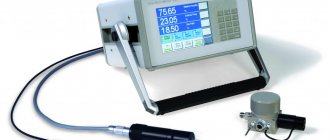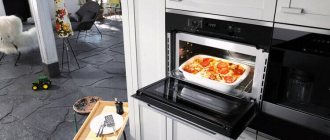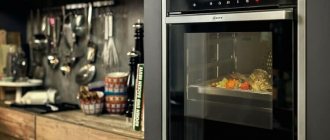Why is convection needed?
In order to understand what convection is, you need to understand how the heating elements are located in an electric oven. Older models of electric stoves were equipped with one or two heating elements and, naturally, they did not have this function. Remember how problematic it was to bake pies or cake layers evenly. One side is already burnt, and the other is not even browned yet. For more or less uniform cooking, it was necessary to endlessly rotate the baking sheet, and in order to prevent the bottom from burning, they placed a second baking sheet with salt.
A modern oven with a convection function will save you from these inconveniences, and you will be able to please your household with a dish with even cooking and a beautiful crispy crust.
How convection works in an oven
The term “convection” refers to the transfer of heat by air flow. Heat exchange in nature occurs naturally. A built-in fan causes air to circulate in the oven. Due to forced convection, the air in the chamber warms up faster and more evenly. A constant heat exchange process ensures the same temperature throughout the entire oven space.
Thanks to uniform heating in the oven, you can cook several dishes at the same time on different levels, and the baked goods do not burn on the bottom and brown on top, meat and vegetables are baked well. At low heat, the convection mode allows you to defrost food.
Household appliances with convection mode, depending on the model, are equipped with a control panel or a corresponding button with an indicator. A fan icon is used to indicate the convection mode on the control panel.
Most often, electric convection ovens and ovens are found on sale, less often gas ones. The cost of devices with convection mode is higher than that of conventional analogues. But the additional cost for an extremely useful function that simplifies the cooking process and allows you to create real culinary masterpieces is worth it.
Free and forced convection
Both of these concepts are interrelated because they characterize the movement of warm air. The free function provides for the spontaneous movement of gas, provoked by the non-uniform density of the medium in the presence of a temperature difference. The forced movement of gas masses is caused by the action of external forces and the uniformity of the field of mass forces. That's why it's called that. Both phenomena are aimed at the cooking process and have corresponding icons on the door.
Free and forced convection differ in that in the second case polar rather than molecular transport of water masses takes place. The convection mode in the oven is especially important for those housewives who are accustomed to pampering their family with homemade baked goods. Under such circumstances, when purchasing, you need to additionally inquire about the size and number of baking sheets.
- Glaze for gingerbread: recipes with photos
- How to clean a hood filter from grease in 5 minutes
- How to weave toys from rubber bands
Types of technology
Technological solutions for implementing forced heat exchange mode in an oven may differ from one manufacturer to another. The following variants of forced convection are common.
- A simple type of forced circulation using a standard power fan.
- Convection by means of a fan with a ring heater. An additional heater, which is equipped with a fan, allows for faster and more efficient heating of the oven space.
- Convector - a more powerful fan creates vortex heat exchange. Baked dishes quickly become crusty, but remain juicy inside, since the resulting crust prevents evaporation.
- A two-level convector consists of two fans below each other. Two-level airflow is convenient when preparing several dishes at the same time.
- Convector with steam generator. Thanks to the saturation of the oven with steam, the dishes turn out stewed, which is healthier. An oven with a moist convection mode is suitable for rich baking and steaming dietary dishes.
Types of convectors
Most often, your electric oven is provided with convection by a fan of a simple design, the function of which is simply to circulate air through the volume. A fan surrounded by an additional heating circuit is more efficient.
Some models of Miele electric stoves have a convenient wet convection function. When this mode is turned on, the air inside the oven is saturated with steam. Dishes do not dry out, the dough rises better, and you can generally steam anything without the harmful frying.
Manufacturers build in reinforced fans into Neff brand ovens that create a rapid flow of hot air. Rapid heating gives a good effect in autumn: the product is quickly covered with a dried layer, which prevents the juices from evaporating during further baking.
Everything said above applies to electric ovens. Until recently, the usual gas stove was deprived of a convenient forced convection mode.
But recently Electrolux launched a new product on the market: now a gas stove can be equipped with a fan to provide forced convection. For now, only a free-standing gas stove can have this function, but it is not a fact that manufacturers will stop developing new models.
The fact is that a gas stove still outsells an electric one, at least when it comes to free-standing stoves. And the Russian market is no exception. Gas in our country is still cheaper than electricity. Therefore, a gas stove is used in 80 out of 100 kitchens. Now those for whom a gas stove is more suitable will also be able to appreciate a gas oven with convection.
How the convection mode is used in practice
In practice, the convector allows you to achieve amazing results. Thick pieces of meat and fish are baked with high quality and get an even crispy crust on all sides. The dish turns out moderately juicy. The mode significantly simplifies the process of preparing complex dishes, while saving energy consumption (gas or electricity).
Important! When the function is activated, the air temperature in the oven is 10-15° higher than with standard heating, which speeds up the cooking process by 20-30%. When setting the timer, the user must take this feature into account.
Application examples.
- Activating the function without heating or with slight heating allows you to quickly defrost food. In this mode, berries, fruits cut into pieces, herbs and zest are dried. You can also place the dough on a baking sheet before baking.
- In convection mode with a bottom heater, pies, pizza and other baked goods are baked.
- The function in combination with the top heater is suitable for preparing casseroles, meat dishes and vegetable and fruit soufflés.
- Multifunctional heating mode with forced circulation is suitable for simultaneous baking of pies on several levels at a temperature of 170-190° or confectionery products (from 180°). You can bake large pieces of meat or fish on several levels (from 200°).
- The turbo grill mode is used for roasting whole poultry, pig, and leg of lamb.
- A steam convector is used when preparing steamed vegetable, meat and fish dishes, and baking buns from butter dough. Can be used to sterilize dishes.
So we figured out what convection is. When using this function in an electric oven, it becomes possible to expand the list of prepared dishes and improve the quality of baking. Nothing will burn and everything will bake evenly!
What does convection do in different types of ovens?
Today, the assortment of the market offers to choose the model that would suit the housewife in everything. Ovens are divided into two main types:
- electrical;
- gas.
In addition, they can be either built-in or free-standing. The most common ones are those that are inseparable from kitchen stoves. If the stove and oven operate on natural gas, the convection function is activated by connecting the device to the electrical network. The auto-ignition system works on the same principle.
Electric built-in cabinet with convection Samsung
Why is convection needed in a gas-powered oven?
Gas stoves with convection gas ovens are in demand due to the fact that this fuel is cheaper than electricity. Externally, they are no different from ordinary ones, but a fan is built into the back wall to ensure uniform heating. The main advantage of a convector in gas stoves is an increase in the heating rate, because with them you usually have to wait much longer for heating to the desired temperature than with electric ones.
It is also sometimes advisable to purchase a separate stove in the form of a cooking surface and a separate built-in gas oven with convection. The convector can be equipped with a steam blowing function. This model will cost more than a standard stove, but will add the ability to prepare healthy steamed dishes.
In a gas cabinet equipped with a convector, it is easy to cook several dishes at the same time
Why do you need convection in an electric oven?
So what is convection in an electric stove oven, and why is it needed? Electric cabinets are considered more powerful than gas cabinets. If in the latter the maximum temperature level is fixed at +230−250°C, then electric ovens quickly and easily heat up to +300°C. In this regard, the question often arises: is convection necessary in an electric oven?
It is easy to prepare any dish in an electric cabinet
The answer is quite obvious: for those who bake a lot, do it professionally, love to cook meat and fish, and conduct experiments at home, this function is simply necessary. This will create uniform heating of the air inside the chamber. The device is available as part of an electric stove, when combining a combination of a gas stove and an electric oven, as an independent built-in cabinet operating exclusively from the mains. You can also buy an electric countertop mini oven with convection if space allows.
Related article:
Why do you need convection in an oven with grill function?
Modern appliances are often equipped with a grill function. It happens:
- electrical;
- gas.
A spit is often included in the kit
When cooking meat on gas, its taste will be close to cooking on charcoal. This distinguishes it favorably from an electric one, which, by the way, is more convenient to use. The blowing function allows you to activate one of the additional buttons:
- air fryer;
- turbo grill.
The air fryer allows you to achieve excellent results and a crispy crust without spit due to uniform heating. Turbo involves the operation of all heating elements and a fan, which allows not only to distribute the heat evenly, but also to cook the dish faster.
Gas grill with convection allows you to cook two dishes at the same time
Recipes for convection ovens are often included with the appliance.
Microwave function operation
For a small family, a microwave can be a good replacement for an oven. Modern models are even equipped with a grill.
Panasonic professional microwave oven
The essence of the convector operation in this case is no different from the standard one: the fan creates pressure of air masses, achieving their uniform distribution. Once the goal is achieved, it turns off. If the temperature drops slightly, the function is automatically switched on again. The cooking speed is reduced by approximately half. For students, a family of two or bachelors, a modern microwave oven is an excellent alternative to an expensive oven. You can also buy an electric tabletop convection oven inexpensively after reading the reviews.
Compact tabletop oven
Related article:











